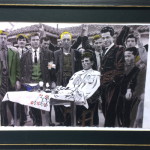Hairy Stories
What is the magic about hair? Why does it carry such a symbolism? Factually hair is made of a tough protein called keratin. In the hair bulb, living cells divide and grow to build the hair shaft. Blood vessels nourish the cells in the hair bulb, and deliver hormones that modify hair growth and structure at different times of life. Children’s hair is smooth and fine. Very often the color changes during adultery. Gray and white hair is the sign of age, in some cultures it is also a symbol of wisdom.
The symbolism around female hair is deeply rooted in human history. Noone will remember, that Medusa was turned into a monster by Pallas Athena to protect her. Actually she had been a beautiful female. After Poseidon had raped her Athena changed Medusa’s hair to snakes and her hands to claws. This part of the story is present until today. Medusa, the hairy monster, that turns men into stone.
Red hair occurs on approximately 1–2% of the human population. Female red hair is associated with eroticism and was partly a reason to burn women as witches in the late middleages in Europe. The fundamentalist men dominated Christianity wanted to erode the power of peoples belief in folk magic.
The Veil as a cover for the hair is first recorded in an Assyrian legal text from 13 century BC. Veling was a privilige for noble women, who didn’t have to work. Also the Harem was originally an Assyrian custom, that was preserved in the region. The Byzantine Empire was famous for the powerful women in the royal Harem, a fact that is just emphasized in a popular TV serial in Turkey reflecting the Ottoman times of Süleyman the magnificant.
Çiğdem Aydemir is a Syndey based artist of Turkish muslim heritage. Her sensitive work on the texture and meaning of hair tells complex stories with different layers. The artist spend some time investigating wig producing shops in Istanbul to find real hair. She produced a human hair cotton/polyester fabric like a rug. The title “to sweep under the carpet” refers to a popular saying in the Angloamerican and European languages and in Turkish as well. While to sweep under the carpet means to hide something in the European languages, in Turkish you have the saying, that women are sweeping the ground with their hair to illustrate their suffering from male violence.
IMG 8848 from InEnArt on Vimeo.
Beisde the hair object two videos are exploring the action of veiling. While the artist used other peoples hair to weave a hair texture, she constructs a headscarf out of her own hair in the Video Hair/Veil. In the Video “an inspiration of victims of the headscarf ban” she is covering her head with wigs and scarfs endlessly.
For centuries headscarfs were banned in Universities and public offices in Turkey. After the 1990th, whern many headscarfed students had protested against the ban, lots of other people started critisizing the exclusion of female students from the universities because of their veils. Some had started wearing wigs instead of scarfs. A ridiculous debasement of the freedom of a Female.
Exhibition: “nothing to see here” by Çiğdem Aydemir at Maumau-Istanbul
Related Posts
Tags: Art, Çiğdem Aydemir, exhibition, Hair, Headscarf, Istanbul, Maumau
Trackback from your site.







